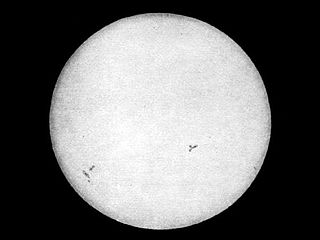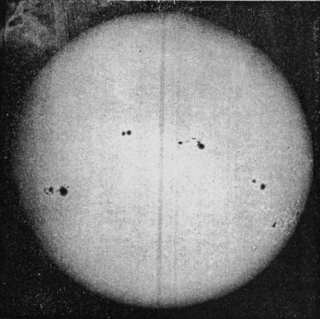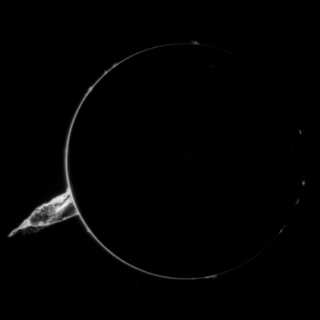Related Research Articles

Sunspots are temporary spots on the Sun's surface that are darker than the surrounding area. They are regions of reduced surface temperature caused by concentrations of magnetic flux that inhibit convection. Sunspots appear within active regions, usually in pairs of opposite magnetic polarity. Their number varies according to the approximately 11-year solar cycle.

The Maunder Minimum, also known as the "prolonged sunspot minimum", was a period around 1645 to 1715 during which sunspots became exceedingly rare. During a 28-year period (1672–1699) within the minimum, observations revealed fewer than 50 sunspots. This contrasts with the typical 40,000–50,000 sunspots seen in modern times over a similar timespan.

Solar maximum is the regular period of greatest solar activity during the Sun's 11-year solar cycle. During solar maximum, large numbers of sunspots appear, and the solar irradiance output grows by about 0.07%. On average, the solar cycle takes about 11 years to go from one solar maximum to the next, with duration observed varying from 9 to 14 years.

The solar cycle, also known as the solar magnetic activity cycle, sunspot cycle, or Schwabe cycle, is a nearly periodic 11-year change in the Sun's activity measured in terms of variations in the number of observed sunspots on the Sun's surface. Over the period of a solar cycle, levels of solar radiation and ejection of solar material, the number and size of sunspots, solar flares, and coronal loops all exhibit a synchronized fluctuation from a period of minimum activity to a period of a maximum activity back to a period of minimum activity.

Solar minimum is the regular period of least solar activity in the Sun's 11-year solar cycle. During solar minimum, sunspot and solar flare activity diminishes, and often does not occur for days at a time. On average, the solar cycle takes about 11 years to go from one solar minimum to the next, with duration observed varying from 9 to 14 years. The date of the minimum is described by a smoothed average over 12 months of sunspot activity, so identifying the date of the solar minimum usually can only happen 6 months after the minimum takes place.

The Wolf number is a quantity that measures the number of sunspots and groups of sunspots present on the surface of the Sun. Historically, it was only possible to detect sunspots on the far side of the Sun indirectly using helioseismology. Since 2006, NASA's STEREO spacecrafts allow their direct observation.

The Gnevyshev–Ohl rule is an empirical rule according to which the sums of Wolf's sunspot numbers over odd cycles are highly correlated with the sums over preceding even cycles and the correlation is lower if even cycles and preceding odd ones are taken. Sometimes a simplified formulation of the rule is used, according to which the sums over odd cycles exceeds those of the preceding even cycles . The rule breaks down under certain conditions. In particular, it inverts sign across the Dalton minimum, but can be restored with the "lost cycle" in the end of the 18th century. The nature of the GO rule is still unclear.

Solar cycle 2 was the second solar cycle since 1755, when extensive recording of sunspot activity began. The solar cycle lasted 9 years, beginning in June 1766 and ending in June 1775. The maximum smoothed sunspot number observed during the solar cycle was 193.0, and the starting minimum was 18.6.
Solar cycle 1 was the first solar cycle during which extensive recording of solar sunspot activity took place. The solar cycle lasted 11.3 years, beginning in February 1755 and ending in June 1766. The maximum smoothed sunspot number observed during the solar cycle was 144.1, and the starting minimum was 14.0.
Solar cycle 4 was the fourth solar cycle since 1755, when extensive recording of solar sunspot activity began. The solar cycle lasted 13.6 years, beginning in September 1784 and ending in April 1798. The maximum smoothed sunspot number observed during the solar cycle was 235.3, and the starting minimum was 15.9.

Solar cycle 5 was the fifth solar cycle since 1755, when extensive recording of solar sunspot activity began. The solar cycle lasted 12.3 years, beginning in April 1798 and ending in August 1810. The maximum smoothed sunspot number observed during the solar cycle was 82.0, in February 1805, and the starting minimum was 5.3.

Solar cycle 6 was the sixth solar cycle since 1755, when extensive recording of solar sunspot activity began. The solar cycle lasted 12.8 years, beginning in August 1810 and ending in May 1823. The maximum smoothed sunspot number observed during the solar cycle was 81.2, in May 1816, and the starting minimum was 0.0.

Solar cycle 7 was the seventh solar cycle since 1755, when extensive recording of solar sunspot activity began. The solar cycle lasted 10.5 years, beginning in May 1823 and ending in November 1833. The maximum smoothed sunspot number observed during the solar cycle was 119.2, and the starting minimum was 0.2.

Solar cycle 9 was the ninth solar cycle since 1755, when extensive recording of solar sunspot activity began. The solar cycle lasted 12.4 years, beginning in July 1843 and ending in December 1855. The maximum smoothed sunspot number observed during the solar cycle was 219.9, and the starting minimum was 17.6. During the solar cycle minimum transit from solar cycle 9 to solar cycle 10, there were a total of 655 days with no sunspots.

Solar cycle 12 was the twelfth solar cycle since 1755, when extensive recording of solar sunspot activity began. The solar cycle lasted 11.3 years, beginning in December 1878 and ending in March 1890. The maximum smoothed sunspot number observed during the solar cycle was 124.4, and the starting minimum was 3.7. During the minimum transit from solar cycle 12 to 13, there were a total of 736 days with no sunspots.

Solar cycle 14 was the fourteenth solar cycle since 1755, when extensive recording of solar sunspot activity began. The solar cycle lasted 11.5 years, beginning in January 1902 and ending in July 1913. The maximum smoothed sunspot number observed during the solar cycle was 107.1, in February 1906, and the starting minimum was 4.5. During the minimum transit from solar cycle 14 to 15, there were a total of 1023 days with no sunspots.
Solar cycle 18 was the eighteenth solar cycle since 1755, when extensive recording of solar sunspot activity began. The solar cycle lasted 10.2 years, beginning in February 1944 and ending in April 1954. The maximum smoothed sunspot number observed during the solar cycle was 218.7, and the starting minimum was 12.9. During the minimum transit from solar cycle 18 to 19, there were a total of 446 days with no sunspots.

Solar cycle 19 was the nineteenth solar cycle since 1755, when extensive recording of solar sunspot activity began. The solar cycle lasted 10.5 years, beginning in April 1954 and ending in October 1964. The International Geophysical Year occurred at the peak of this solar cycle.

Solar cycle 25 is the current solar cycle, the 25th since 1755, when extensive recording of solar sunspot activity began. It began in December 2019 with a minimum smoothed sunspot number of 1.8. It is expected to continue until about 2030.
Solar observation is the scientific endeavor of studying the Sun and its behavior and relation to the Earth and the remainder of the Solar System. Deliberate solar observation began thousands of years ago. That initial era of direct observation gave way to telescopes in the 1600s followed by satellites in the twentieth century.
References
- ↑ "Sunspot numbers". WDC-SILSO. Royal Observatory of Belgium. Retrieved 19 May 2017.
- ↑ Hathaway, D. (2015). "The solar cycle". Living Reviews in Solar Physics. 12 (1): 4. arXiv: 1502.07020 . Bibcode:2015LRSP...12....4H. doi:10.1007/lrsp-2015-4. PMC 4841188 . PMID 27194958.
- ↑ Usoskin; Mursula; Kovaltsov (2001). "Heliospheric modulation of cosmic rays and solar activity during the Maunder minimum". J. Geophys. Res. 106(A8) (A8): 16039. Bibcode:2001JGR...10616039U. doi: 10.1029/2000JA000105 .
- ↑ Usoskin; et al. (2009). "A solar cycle lost in 1793-1800: Early sunspot observations resolve the old mystery". Astrophys. J. Lett. 700 (2): L154. arXiv: 0907.0063 . Bibcode:2009ApJ...700L.154U. doi:10.1088/0004-637X/700/2/L154. S2CID 14882350.
- ↑ Usoskin; et al. "Solar cyclic activity over the last millennium reconstructed from annual 14C data". Astron. Astrophys. 649: A141. arXiv: 2103.15112 . doi:10.1051/0004-6361/202140711.
- ↑ "SIDC smoothing formula". WDC-SILSO. Royal Observatory of Belgium. Retrieved 19 May 2017.
- ↑ Meeus, J. (1958). "Une formule d'adoucissement pour l'activité solaire". Ciel et Terre. 74: 445. Bibcode:1958C&T....74..445M.
- ↑ "The solar cycle's new clothes". STCE. Royal Observatory of Belgium. Retrieved 8 July 2015.
- ↑ "December 2019 confirmed as starting point of the new solar activity cycle". SIDC.
- ↑ "Spotless Days Page". SILSO. Royal Observatory of Belgium. Retrieved 3 April 2017.
